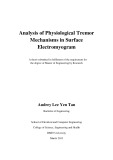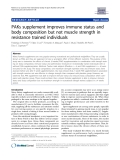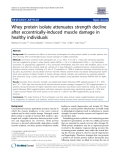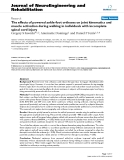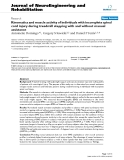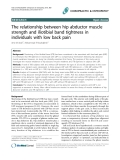
Individual muscles
-
The objective of this research was to determine the role of neural feedback and muscle mechanics in the generation of physiological tremor oscillation. This research developed a neuromuscular model to simulate the individual and resulting oscillatory mechanisms of tremor. The oscillations found in EMG signal were also analysed empirically from EMG data from 54 subjects using Hilbert Transform and rectification to obtain the envelope of the signal. The time between rhythmical waveform patterns in the EMG signal, TC was found to be 78ms.
 117p
117p  runthenight07
runthenight07
 01-03-2023
01-03-2023
 7
7
 3
3
 Download
Download
-
Tuyển tập báo cáo các nghiên cứu khoa học quốc tế ngành y học dành cho các bạn tham khảo đề tài: PAKs supplement improves immune status and body composition but not muscle strength in resistance trained individuals
 6p
6p  dauphong1
dauphong1
 22-12-2011
22-12-2011
 54
54
 4
4
 Download
Download
-
Tuyển tập báo cáo các nghiên cứu khoa học quốc tế ngành y học dành cho các bạn tham khảo đề tài: Whey protein isolate attenuates strength decline after eccentrically-induced muscle damage in healthy individuals
 9p
9p  dauphong1
dauphong1
 22-12-2011
22-12-2011
 76
76
 8
8
 Download
Download
-
Tuyển tập báo cáo các nghiên cứu khoa học quốc tế ngành y học dành cho các bạn tham khảo đề tài: The effects of powered ankle-foot orthoses on joint kinematics and muscle activation during walking in individuals with incomplete spinal cord injury
 17p
17p  panasonic03
panasonic03
 16-12-2011
16-12-2011
 57
57
 3
3
 Download
Download
-
Tuyển tập báo cáo các nghiên cứu khoa học quốc tế ngành y học dành cho các bạn tham khảo đề tài: Predicting muscle forces of individuals with hemiparesis following stroke
 16p
16p  panasonic01
panasonic01
 12-12-2011
12-12-2011
 47
47
 4
4
 Download
Download
-
Tuyển tập báo cáo các nghiên cứu khoa học quốc tế ngành y học dành cho các bạn tham khảo đề tài: Kinematics and muscle activity of individuals with incomplete spinal cord injury during treadmill stepping with and without manual assistance
 14p
14p  panasonic01
panasonic01
 12-12-2011
12-12-2011
 34
34
 3
3
 Download
Download
-
Tuyển tập các báo cáo nghiên cứu về y học được đăng trên tạp chí y học Critical Care giúp cho các bạn có thêm kiến thức về ngành y học đề tài: The relationship between hip abductor muscle strength and iliotibial band tightness in individuals with low back pain...
 5p
5p  coxanh_5
coxanh_5
 28-10-2011
28-10-2011
 41
41
 4
4
 Download
Download
-
Spinal Muscles The spinal muscles are a complicated group of muscles that pass along the back of the animal from the pelvis to the middle of the neck. Each muscle consists of numerous overlapping bundles that continuously originate and insert along the spine. They lie on either side of the upper surface of the vertebral column, separated by the upright spines. This powerful muscle group consists of four units: the longissimus, the iliocostalis, the spinalis & semispinalis, and the multifidus, all of which may be divided into regional components (cervicis, thoracis & lumborum).
 14p
14p  audi123
audi123
 31-07-2010
31-07-2010
 128
128
 13
13
 Download
Download
-
Short Neck Muscles The following three muscles are located on the back of the neck, just behind the skull: the obliquus capitis caudalis, the obliquus capitis cranialis, and the rectus capitis dorsalis major. They are covered by narrow and wide tendons and thin muscles, yet they help create the fullness on the back of the neck, determined in large part by the width of the atlas (the first neck vertebra) and the vertical projection of the axis (the second neck vertebra).
 10p
10p  audi123
audi123
 31-07-2010
31-07-2010
 116
116
 16
16
 Download
Download
-
Introduction The muscles of the head consist of the chewing muscles (temporalis, masseter, and digastric) and the facial muscles (zygomaticus, orbicularis oris, etc.). The chewing muscles are thick and volumetric, and they originate and insert on bone. They open and close the lower jaw, with the action taking place at the jaw joint (temporomandibular joint). The facial muscles are thin. They originate either from the skull or from the surface of other muscles, and they generally insert into other facial muscles or into the skin.
 14p
14p  audi123
audi123
 31-07-2010
31-07-2010
 156
156
 22
22
 Download
Download
CHỦ ĐỀ BẠN MUỐN TÌM








